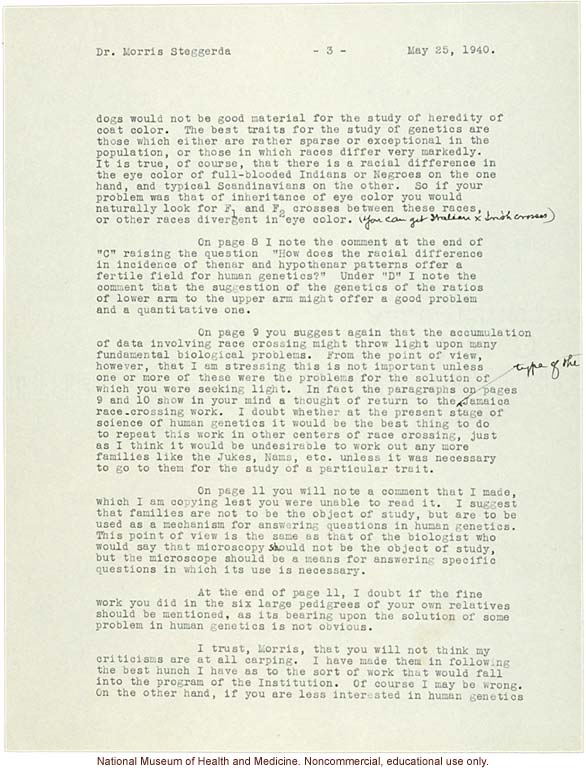Dr. Morris Steggerda -3- May 25, 1940.
dogs would not be good material for the study of heredity of coat color. The best traits for the study of genetics are those which either are rather sparse or exceptional in the population, or those in which races differ very markedly. It is true, of course, that there is a racial difference in the eye color of full-blooded Indians or Negroes on the one hand, and typical Scandinavians on the other. So if you problem was that of inheritance of eye color you would naturally look for F[inferior]1[end inferior] and F[inferior]2[end inferior] crosses between these races, or other races divergent in eye color. [handwritten](You can get Italian x Irish crosses)[end handwritten]
On page 8 I note the comment at the end of "C" raising the question "How does racial difference in incidence of thenar and hypothenar patterns offer a fertile field for human genetics?" Under "D" I note the comment that the suggestion of the genetics of the ratios of lower arm to the upper arm might offer a good problem and a quantitative one.
On page 9 you suggest again that the accumulation of data involving race crossing might throw light upon many fundamental biological problems. From the point of view, however, that I am stressing this is not important unless one or more of these were the problems for the solution of which you were seeking light. In fact the paragraphs on pages 9 and 10 show in your mind a thought of return the type of the Jamaica race-crossing work. I doubt whether at the present stage of science of human genetics it would be the best thing to do to repeat this work in other centers of race crossing, just as I think it would be undesirable to work out any more families like the Jukes, Nams, etc. unless it was necessary to go to them for the study of a particular trait.
On page 11 you will note a comment that I made, which I am copying lest you were unable to read it. I suggest that families are not to be the object of study, but are to be used as a mechanism for answering questions in human genetics. This point of view is the same as that of the biologist who would say that microscopy should not be the object of study, but the microscope should be a means for answering specific questions in which its use is necessary.
At the end of page 11, I doubt if the fine work you did in the six large pedigrees of your own relatives should be mentioned, as its bearing upon the solution of some problem in human genetics is not obvious.
I trust, Morris, that you will not think my criticisms are at all carping. I have made them in following the best hunch I have as to the sort of work that would fall into the program of the Institution. Of course I may be wrong. On the other hand, if you are less interested in human genetics
[end]


